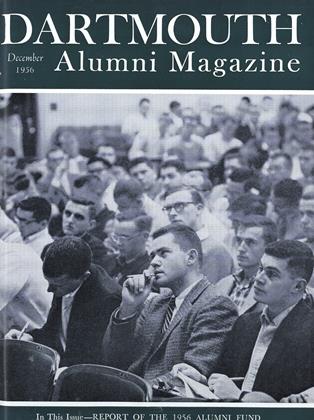IN its annual report on the freshman class the Committee on Admission and the Freshman Year this fall included some comparisons with the Class of 1940 to indicate trends over the past twenty years. Most interesting of these comparisons is the increased representation of the Far West and the South in the student body. Using figures for the entering classes twenty years apart, the Far West has risen from 4.7% to 9.0% of the class and the South from 1.7% to 5.1%. This shift has occurred at the expense of New England, which has dropped from 36.6% to 23.8% in twenty years. The Middle Atlantic states have also gained, 40.4% to 36.5%, while the Middle West has remained relatively stable. An increase from 0.8% to 1.7% for foreign students is another striking postwar development.
The tremendous increase in the work of the Admissions Office is indicated by these figures: for the Class of 1940 there were 1,992 preliminary applications and 1,411 completed ones, for the Class of 1960 there were 5,703 preliminary applications and 3,500 completed ones. In the same period the target figure for the entering class has risen by about 100 men, from 650 to 750. Last year the Admissions Office distributed 14,500 copies of the General Information Bulletin and wrote 7,500 separate letters in response to initial inquiries.
In previous issues this fall we have reported on the high academic potential of the Class of 1960, as indicated by College Entrance Board aptitude tests. The Committee report shows that 1960 scored well ahead of last year's blue-ribbon freshman class, 601.6 to 585.3 on the mathematical part of the tests and 568.5 to 548.7 on the verbal part. A remarkably high percentage (79.1) of the freshmen ranked in the top quarter of their graduating classes. This compares with 71.2 for 1959 and 68.0 for 1958. A more select group who ranked in the top tenth of their classes comprises 40.7% of the freshman class.
A record total of 498 secondary schools are represented in the Class of 1960. The figure twenty years ago was 388 schools. An especially striking trend during the past two decades has taken place in the division between men entering from public and private schools. For the Class of 1940 the division was exactly 50-50; for the Class of 1960, public schools provided 72% and private schools 28%.
The recent trend toward an increased ROTC enrollment continues with the present freshman class. A total of 336 freshmen (42% of the class) are in the Army, Navy and Air Force Units, compared with 283 men (38%) last year and only 339 (31.7%) two years ago.
 View Full Issue
View Full Issue
More From This Issue
-
 Feature
FeatureGOTHAM GAMBIT:
December 1956 By KIMBALL FLACCUS '33 -
 Feature
FeatureCLASS ACHIEVENTS, 1956 FUND
December 1956 -
 Feature
FeatureSTUDENT LOANS
December 1956 -
 Feature
FeatureTHE 1956 ALUMNI FUND
December 1956 By William G. Morton '28 -
 Feature
FeatureTONS OF MAPS
December 1956 By CLIFFORD L. JORDAN '45 -
 Class Notes
Class Notes1953
December 1956 By RICHARD C. CAHN, LT. (JG) EDWARD F. BOYLE, RICHARD CALKINS
Article
-
 Article
ArticleAlumni Articles
May 1952 -
 Article
ArticleA Wah Hoo Wah for –
JULY 1966 -
 Article
ArticleAnd furthermore ...
April 1975 -
 Article
ArticleArt Thibodeau Stricken
November 1951 By Francis E. Merrill '26 -
 Article
ArticleErnest Martin Hopkins: A 25-Year Retrospect
April 1941 By LEON BURR RICHARDSON '00 -
 Article
ArticleOf Much Promise
February 1935 By The Editors

